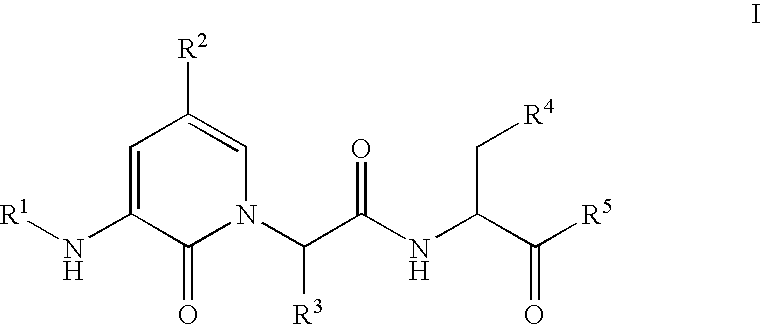Caspase inhibitors and uses thereof
a technology of caspase inhibitors and inhibitors, applied in the field of medicinal chemistry, can solve the problems of poor oral absorption, undesirable pharmacological properties of peptide inhibitors, and inability to reflect potency in cellular models
- Summary
- Abstract
- Description
- Claims
- Application Information
AI Technical Summary
Problems solved by technology
Method used
Image
Examples
example ii.1
3(R,S)-[2(S)-(3-Benzoylamino-2-oxo-2H-pyridin-1-yl)-3-phenyl-propionylamino]-5-fluoro-4-oxo-pentanoic acid
[0201]
Method A:
(S)-2-(3-Benzyloxycarbonylamino-2-oxo-2H-pyridin-1-yl)-3-phenyl-propionic acid tert-butyl ester
[0202]
[0203] To a cooled (0° C.) solution of (R)-2-Hydroxy-3-phenyl-propionic acid tert-butyl ester (2.50 g,-15.6 mmol) in dichloromethane (50 mL), was slowly added 2,6-lutidine (3.3 g, 30.8 mmol) and then trifluoromethanesulfonic anhydride (8.25 g, 29.2 mmol). The resulting mixture was stirred at 0C for 1 hour, then partitioned between tert-butylmethyl ether (200 mL) and an aqueous solution of 1M HCl (60 mL). The organic layer was washed with brine (60 mL), dried (sodium sulfate), filtered and concentrated to afford the triflate as a light brown oil.
[0204] To a solution of (2-oxo-1,2-dihydro-pyridin-3-yl)-carbamic acid benzyl ester (P. Warner et al., J. Med. Chem., 37, 19, 1994, 3090-3099)(4.34 g, 17.8 mmol) in dry THF (100 mL) was added sodium hydride (60% dispers...
example ii.2
3(R,S)-[2(S)-(3-Benzoylamino-2-oxo-2H-pyridin-1-yl)-4-phenyl-butyrylamino]-5-fluoro-4-oxo-pentanoic acid
[0217]
[0218] Prepared according to methods A and D-G using N-(2-Oxo-1,2-dihydro-pyridin-3-yl)-benzamide and (R)-2-hydroxy-4-phenyl-butyric acid tert-butyl ester (prepared using a method similar to that reported in Lei et al., J. Carbohydrate Chemistry, 15, 4, 1996, 485-500) in method A; white solid; IR (solid) 1643, 1578, 1521, 1490, 1213, 753 cm−1; 1H NMR (400 Mhz, d6-DMSO) δ 2.3-2.9 (6H, m), 3.5-3.7 (2H, m), 4.3-4.7 (3H, m), 5.1-5.35 (1.5H, m), 5.6-5.8 (1H, m), 6.4-6.45 (1H, m), 7.2-7.35 (5H, m), 7.6-7.8 (4H, m), 7.9-8.0 (2H, m), 8.3-8.35 (1H, m), 8.9-9.0 (1H, m), 9.35-9.4 (1H, m); M+H 508.4, M−H 506.4.
example ii.3
3(R,S)-[2(S)-(3-Benzoylamino-5-methyl-2-oxo-2H-pyridin-1-yl)-3-phenyl-propionylamino]-5-fluoro-4-oxo-pentanoic acid
[0219]
[0220] Prepared according to methods A and D-G using N-(5-methyl-2-oxo-1,2-dihydro-pyridin-3-yl)-benzamide and (R)-2-Hydroxy-3-phenyl-propionic acid tert-butyl ester in step A; white solid; IR (solid) 1650, 1516, 1224, 692 cm−1; 1H NMR (400 MHz, d6-DMSO) δ 0.83-0.86 (3H, m), 2.30-2.67 (4H, m), 4.32-4.95 (2H, m), 5.12-5.24 (1H, m), 5.83-6.04 (1H, m), 7.15-7.61 (9H, m), 7.86-7.88 (2H, m), 8.11-8.12 (1H, m, 8.70-9.02 (1H, m), 9.21 (1H, d), 12.41 (1H, br s); M+H 508.4, M−H 506.4.
PUM
 Login to View More
Login to View More Abstract
Description
Claims
Application Information
 Login to View More
Login to View More - R&D
- Intellectual Property
- Life Sciences
- Materials
- Tech Scout
- Unparalleled Data Quality
- Higher Quality Content
- 60% Fewer Hallucinations
Browse by: Latest US Patents, China's latest patents, Technical Efficacy Thesaurus, Application Domain, Technology Topic, Popular Technical Reports.
© 2025 PatSnap. All rights reserved.Legal|Privacy policy|Modern Slavery Act Transparency Statement|Sitemap|About US| Contact US: help@patsnap.com



